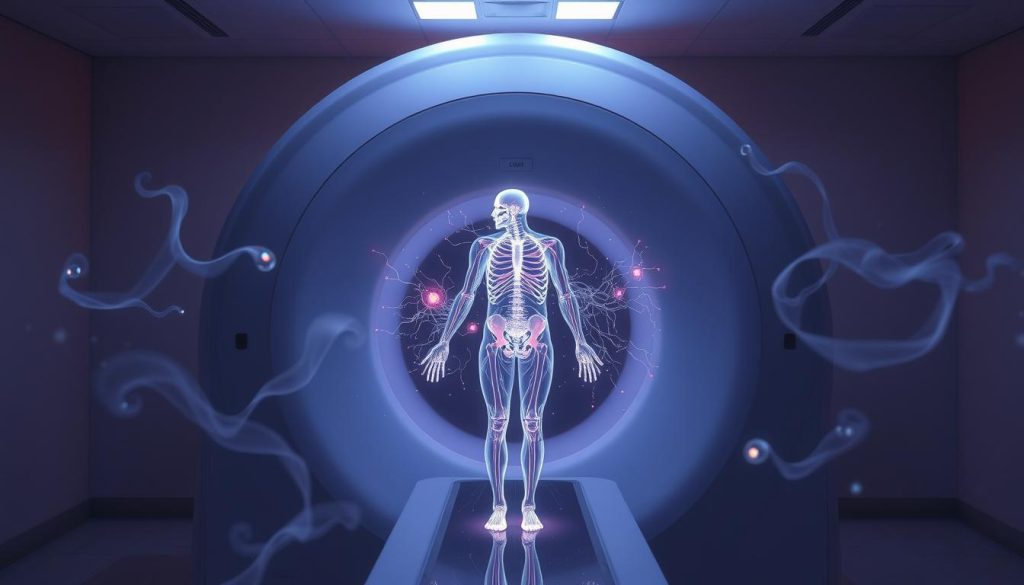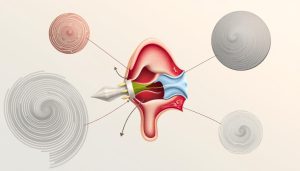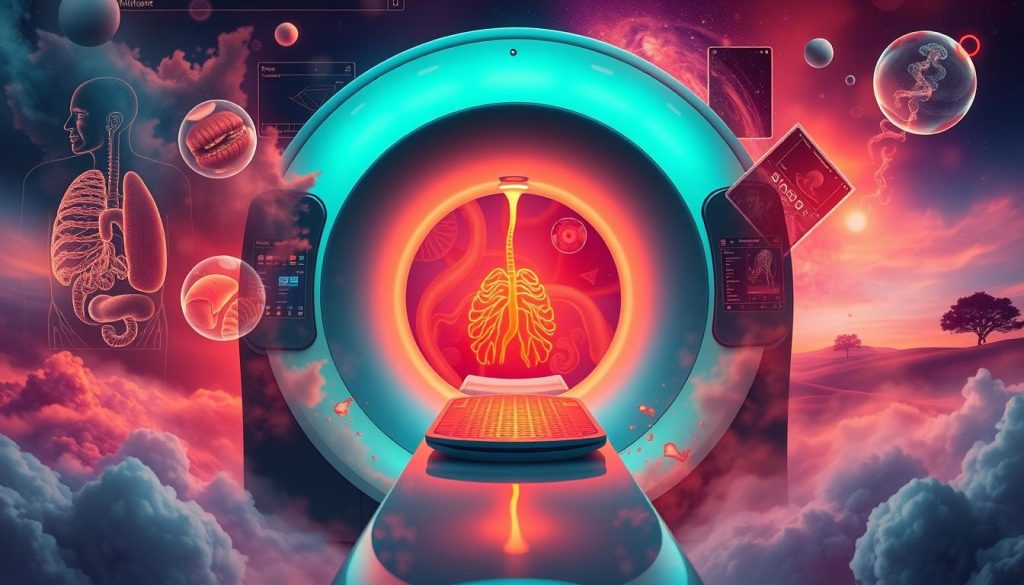A CT scan with contrast for abdomen and pelvis is key for doctors and patients. It gives detailed images to spot many health issues. But, it’s important to know about possible CT scan contrast dye side effects.
These side effects are rare but can be serious. They might cause mild discomfort or a severe allergic reaction. Knowing these CT scan contrast reaction symptoms helps patients and doctors talk better about health.
We want to make you aware of these side effects. Knowing what to expect can help you spot problems early. This way, you can act fast if any side effects happen. Remember, being informed makes you safer.
Understanding CT Scans with Contrast: A Primer
Computed Tomography (CT) scans are key in today’s medicine, thanks to contrast material. They give detailed views of the abdomen and pelvis. This is vital for accurate diagnosis and treatment plans.
What is a CT Scan with Contrast?
A CT scan with contrast uses a special dye to light up certain body parts. This dye makes images clearer than regular CT scans. It’s essential for finding diseases in complex areas like the abdomen and pelvis.
Why Contrast is Used in Abdomen and Pelvis Scans
Contrast materials are vital for abdominal and pelvic scans. They highlight blood vessels and the intestinal tract. This gives doctors high-resolution images to spot issues like small tumors or inflammation.
Using CT scans with contrast helps avoid missed diagnoses. It ensures treatments are targeted and effective.

It’s important for patients to know about CT scan abdominal and pelvic side effects from contrast use. These can range from mild to severe, including reactions to the dye. Before a CT scan, talk to your doctor about CT scan contrast material risks. This helps make a decision that fits your health needs.
Common Side Effects of CT Contrast Dye
CT scans often use contrast dye to make certain body parts more visible. This dye can cause side effects, from mild to moderate. Knowing about these effects and how to treat them can help make the experience less uncomfortable and safer for patients.
Mild Reactions to Contrast Material
Mild side effects of contrast dye are common. They might feel like warmth or a brief cold when the dye is injected. Some people might get a little itch or feel a bit sick, but these usually go away fast without needing a lot of medical help.
Talking about these possible reactions with your doctor before the scan can help. It can make you feel less worried about what might happen during the procedure.
Identifying Moderate Side Effects
Moderate reactions are less common but need quick attention. They might include more serious nausea, vomiting, or even allergic reactions like hives. It’s important to catch these early and treat them right away, often with medicine to help with symptoms.
Hospitals and clinics are ready to handle CT scan contrast injection complications. They have the right treatments and medicines to keep patients safe and comfortable.
Teaching patients about possible side effects and treatments is key. It helps them know what to do if they start to feel worse. This way, both patients and doctors can make the CT scan process smoother and safer.
Potential Allergic Reactions to CT Scan Contrast
Most people have mild or no CT scan contrast dye side effects when they get a CT scan with contrast. But, some might have serious allergic reactions. It’s important to spot these quickly to handle them well.
These reactions usually show up right after the dye is given. Spotting them early is key to managing risks.
- Itching or hives
- Swelling of the throat or other parts of the body
- Difficulty breathing
- Palpitations or tachycardia
- Anaphylactic shock
Quick action is needed to treat these reactions. Doctors focus on CT scan contrast reaction management. They first check how bad the reaction is. Then, they give medicines like antihistamines, steroids, or epinephrine if needed.
Patients often need to stay in the hospital for care. This helps them get better and keeps them safe. It also helps doctors learn how to avoid these serious reactions in the future.
CT Scan with Contrast Abdomen and Pelvis Side Effects
After a CT scan with contrast for the abdomen and pelvis, patients might feel some side effects. These can be mild or serious and need quick medical help. Knowing what to expect can make you feel better and safer.
What to Expect Post-Procedure
Most people feel a bit uncomfortable but it usually goes away without treatment. You might feel warm, taste metal, or have a bit of skin flushing. These feelings usually go away fast.
When to Seek Medical Attention
Watch for signs of a bad reaction to the dye. Hives, itching, trouble breathing, swelling, or dizziness mean you need help fast. Getting medical help right away is key.
The table below shows when to talk to a doctor:
| Side Effect | Advisability of Seeking Medical Consultation |
|---|---|
| Mild allergic reactions (e.g., itchiness, minor rash) | Monitor at home, contact your doctor if symptoms persist or worsen |
| Severe allergic reactions (e.g., difficulty breathing, swelling of face or limbs) | Seek immediate medical attention |
| Nausea or mild discomfort | Common and generally not a concern unless severe or persistent |
| Severe pain at the injection site or elsewhere | Contact healthcare provider as soon as possible |
Navigating CT Scan Contrast Injection Complications
It’s important to know how to handle problems from CT scan contrast injections. This part talks about the issues and how to manage them in CT scan contrast reaction management.
After a CT scan contrast injection, problems can be small or serious. Spotting early signs of trouble can make a big difference. Here’s a list of common issues and how doctors deal with them.
- Mild Allergic Reactions: These show as itching or hives. Doctors usually give antihistamines to treat them.
- Moderate Allergic Reactions: Symptoms like wheezing or breathing trouble are treated with strong antihistamines and steroids.
- Severe Reactions: These can cause heart problems or anaphylaxis. They need quick emergency care.
Handling CT scan contrast injection complications well needs both prevention and quick action. The table below shows how doctors manage and prevent these problems.
| Complication Level | Preventive Measures | Emergency Response |
|---|---|---|
| Mild | Pre-scan check for allergies | Antihistamines given on-site |
| Moderate | Assessing risks, looking at patient history | Antihistamines and steroids given |
| Severe | Having emergency equipment ready | Epinephrine and emergency help |
For healthcare, keeping up with CT scan contrast reaction management training is key. This means always using the latest and best treatment methods. This way, dealing with contrast injection risks becomes safer and more efficient, focusing on patient safety.
In-Depth: CT Scan Contrast Material Risks
It’s important to know the risks of CT scan contrast materials. This is true for both patients and healthcare providers. We’ll look at how some conditions can make these risks worse. We’ll also talk about how to prevent reactions to CT scan contrast.
Understanding the Risks Before Your Scan
Before a CT scan, knowing the risks of contrast materials is key. These risks can range from mild allergic reactions to serious, life-threatening issues. Learning about these risks is the first step in staying safe.
How Pre-Existing Conditions Affect Risk Levels
People with certain health conditions may face higher risks from CT scan contrast materials. For example, those with kidney problems or a history of asthma might be more likely to have bad reactions.
- Detailed review of medical history
- Assessment of current medications
- Discussion of previous reactions to contrast materials, if any
Talking about these factors with your doctor is vital. It helps lower risks and makes the scan safer for you.
| Condition | Risk Level Increase | Preventive Measures |
|---|---|---|
| Kidney Impairment | High | Pre-scan kidney function test, use of alternative contrast |
| Asthma | Moderate to High | Use of low-osmolality contrast material |
| Known Allergies to Contrast Dye | High | Premedication, readiness for emergency interventions |
Knowing these details is important for getting ready for a CT scan. It’s also key in preventing bad reactions. By taking these steps, both patients and doctors can lower the chance of problems.
Handling CT Scan Contrast Reaction Symptoms
When you have a CT scan with contrast dye, knowing the CT scan contrast dye side effects is key. Quick action and the right response can prevent serious health issues.
Symptoms can range from mild itching to serious problems like trouble breathing. It’s important to know how to handle these symptoms to keep you safe. We’ll look at both first steps and further actions needed for CT scan contrast reaction treatment.
- Observation Post-Scan: Watch for any bad reactions for at least 30 minutes after getting the contrast dye.
- Preparation of Emergency Medication: Have antihistamines and steroids ready to treat allergic reactions fast.
- Training of Medical Staff: Make sure all medical staff know how to handle CT scan contrast reactions well.
If you have symptoms after leaving the hospital, knowing when to get more CT scan contrast reaction treatment is vital. Signs like long-lasting dizziness, swelling, or pain at the injection site need quick medical help.
Following these steps can greatly lower the risks of CT scan contrast dye side effects for both patients and healthcare teams.
Immediate and Long-Term Side Effects
When you get a CT scan with contrast in your abdomen and pelvis, you might feel some side effects right away or later. This part talks about the quick discomforts and why it’s key to watch your health closely over time.
Short-Term Discomfort and Symptoms
After a CT scan with contrast in your abdomen and pelvis, you might feel some things right away. These feelings are usually mild but can sometimes be strong. You might feel warmth or cold, taste something metallic, or feel a bit dizzy.
Knowing these feelings are common can help you feel better and get ready for what’s coming.
Other symptoms you might see include:
- Nausea
- Vomiting
- Headache
- Itching
- Skin rashes
It’s very important to watch how you feel after the scan. If you have any symptoms that don’t go away or get worse, tell your doctor right away.
Monitoring for Delayed Reactions
Some side effects from a CT scan with contrast in your abdomen and pelvis might show up later. This is why it’s so important to keep an eye on your health after the scan. If you have kidney problems, you might be at risk for kidney issues later on.
It’s vital for both you and your doctor to watch out for these late reactions. They could include:
- Persistent pain at the injection site
- Late allergic reactions
- Signs of infection
It’s a good idea to keep track of any unusual symptoms or health problems after your scan. Talk about them with your doctor.
By knowing about both the quick and late side effects of a CT scan with contrast, you can be more ready and involved in taking care of your health after the scan.
Strategies for CT Scan Contrast Reaction Management
Managing and preventing reactions to CT scan contrast is key in modern medical imaging. This part looks at ways to stop and handle these reactions. It aims to keep patients safe and comfortable.
Pre-Scan Precautions to Minimize Reactions
Before a CT scan, several steps can lower the risk of contrast reactions. These include:
- Checking the patient’s medical history for allergies or kidney problems.
- Using antihistamines or steroids for those at risk.
- Guiding patients on how much water to drink before the scan.
These steps help prevent and manage CT scan contrast reactions.
Post-Scan Care and Observation
After the contrast is given, watching the patient closely is important:
- Keep an eye on the patient for at least 30 minutes for any bad signs.
- Make sure the patient knows what to watch for and when to seek help.
- Check in with the patient later to see how they’re doing.
This careful approach to managing CT scan contrast reactions helps patients get the right care quickly.
By taking steps before and after the scan, doctors can greatly reduce the risk of bad reactions. This protects patients’ health during important tests.
CT Scan Contrast Reaction Prevention
Keeping patients safe and comfortable during CT scans is key. Healthcare providers focus on preparation and medical history to lower risks. This section looks at how to prevent CT scan contrast reactions effectively.
Best Practices to Reduce the Chances of a Reaction
Using the right precautions is vital for safe CT scans. Drinking plenty of water helps the body handle contrast better. Also, checking for allergies before the scan is important for patient safety.
- Ensure hydration before and after the CT scan
- Conduct thorough pre-procedure interviews to identify possible risk factors
- Use non-ionic, low-osmolarity contrast agents to minimize reaction risks
The Role of Medical History in Contrast Use
Knowing a patient’s medical history is critical. Doctors look at past CT scan contrast reaction treatment and allergies. This helps choose the right contrast and dosage for each patient.
| Factor | Impact on CT Contrast Use |
|---|---|
| Previous Allergic Reactions | May indicate a need for premedication or alternative imaging methods |
| Kidney Function | Essential to assess as compromised kidneys may affect contrast elimination |
| Heart Diseases | Patients with cardiovascular issues may require closer monitoring |
Treatment Protocols for CT Scan Contrast Reaction
When a patient has a reaction to contrast material in a CT scan, quick action is key. This part talks about the CT scan contrast reaction treatment and management plans. These are based on guidelines from top medical groups.
First steps usually include giving antihistamines and corticosteroids for mild to moderate allergies. For serious reactions, epinephrine and airway care are needed fast. Hospitals should have a plan for these steps and train staff to act quickly.
| Reaction Severity | First Response | Additional Measures |
|---|---|---|
| Mild Allergic Reaction | Antihistamines | Observation for changes |
| Moderate Allergic Reaction | Corticosteroids | Oxygen therapy |
| Severe Allergic Reaction | Epinephrine | Emergency airway management |
Long-term care for CT scan contrast reaction management might include regular check-ups. This is true for those who had big reactions. Having these plans in place can greatly lower the chance of serious problems after a CT scan with contrast.
- Immediate access to emergency medications
- Trained medical staff ready to handle contrast reactions
- Post-procedure monitoring for late-appearing symptoms
Knowing and using these treatment plans makes patients safer. It also makes doctors more confident in using contrast for scans. With strict CT scan contrast reaction treatment plans, doctors can handle risks better and care for patients well.
Discussing Your Concerns: CT Scan with Contrast
Before a CT scan with contrast, it’s key to know the risks and talk to your doctor. Discussing concerns about contrast material risks and possible reactions is important. It helps keep you comfortable and safe after the scan.
Questions to Ask Your Doctor Before the CT Scan
Ask your doctor lots of questions to avoid reaction symptoms and understand risks:
- What are the common and rare CT scan contrast reaction symptoms?
- Considering my medical history, what are my specific risks with CT scan contrast material?
- How is a reaction to the contrast material typically handled during and after the procedure?
- Are there alternatives to using contrast material in my scan?
Understanding the Consent Process
The consent process for a CT scan with contrast is very important. It makes sure you understand the risks and what to expect. This is key for your safety.
Informed consent means you know all the benefits and risks. This helps you decide if you want to have the scan with contrast.
Knowing the right questions and the consent process makes your CT scan safer and more informed. This is good for you.
Advancements in CT Scan Contrast Safety
Medical technology keeps getting better, and so does the safety of tests like CT scans. The focus on CT scan contrast material risks has made big strides. This is thanks to ongoing research in radiology and pharmacology, all aimed at keeping patients safe.
New contrast agents are being developed to be safer and work better. These agents are gentler on the body and help doctors get clear images. Studies are being done to see how well these agents work and if they cause fewer side effects.
There are also new tools to help during CT scans. These tools can spot problems early and act fast. The goal is to make each scan safer and more precise. This means patients can feel more confident and have better care.
FAQ
Q: What side effects may occur with a CT scan with contrast for the abdomen and pelvis?
A: You might feel warm, get nausea, or have hives. In rare cases, severe allergic reactions can happen. Knowing these risks is key before the procedure.
Q: Why is contrast used in abdomen and pelvis CT scans?
A: Contrast agents make internal organs and tissues more visible. This helps doctors get a clearer diagnosis of conditions in the abdomen and pelvis.
Q: What are mild reactions to CT scan contrast material?
A: Mild reactions include feeling warm, a metallic taste, or mild nausea. You might also get temporary hives and itching. These usually go away on their own or with simple treatments.
Q: How are moderate side effects of CT contrast dye identified?
A: Moderate side effects include nausea that lasts longer, vomiting, or rashes. You might also have shortness of breath or abnormal heart rhythms. These need quick medical attention and treatment.
Q: What should I expect post-procedure after a CT scan with contrast?
A: After the scan, you might feel warm or have a slight headache. These symptoms are usually short-lived.
Q: When should I seek medical attention after undergoing a CT scan with contrast?
A: Get medical help if you have trouble breathing, swelling, a severe rash, persistent vomiting, or chest pain after the scan.
Q: What are the risks associated with CT scan contrast material?
A: Risks depend on your health history. They can include kidney problems, allergic reactions, or rare anaphylaxis. Always talk to your doctor about your medical history.
Q: What are some strategies for managing CT scan contrast reactions?
A: To manage reactions, test for sensitivity before the scan. Use different contrast agents if needed. Monitor patients closely during and after the procedure to handle any reactions quickly.
Q: How can I prevent a reaction to CT scan contrast?
A: Tell your healthcare provider about any past reactions or allergies. If you have kidney problems, let them know. Pre-medication might be considered in some cases.
Q: What are the treatment protocols for a CT scan contrast reaction?
A: Treatment depends on the reaction’s severity. It might include antihistamines, steroids, or adrenaline for anaphylaxis. Supportive care like IV fluids and oxygen may also be needed.
Q: What questions should I ask my doctor before a CT scan with contrast?
A: Ask about the contrast’s necessity, risks, and how they apply to your health. Also, ask about possible side effects and how risks will be managed.
Q: How are advancements in CT scan contrast safety improving patient care?
A: New research is creating safer contrast agents. Improved protocols for managing reactions and better pre-scan screening are also being developed. These advancements aim to enhance patient safety.


















